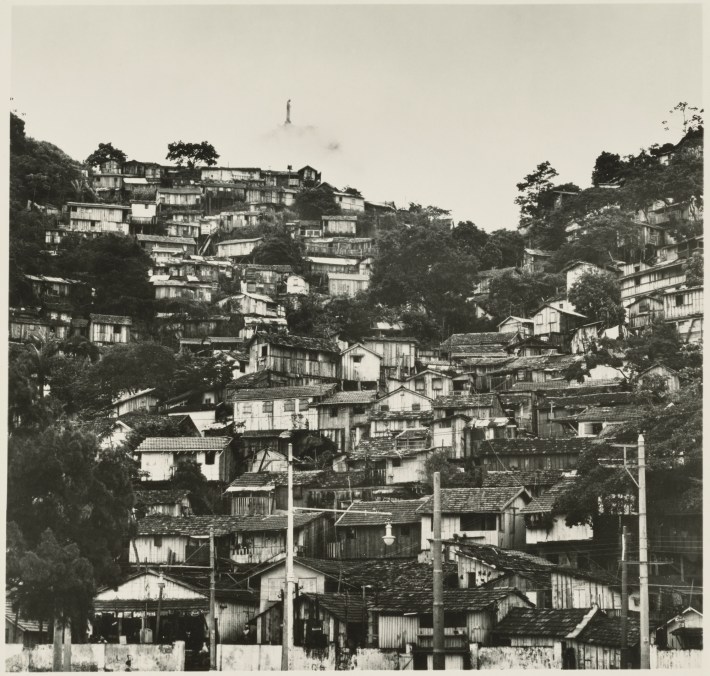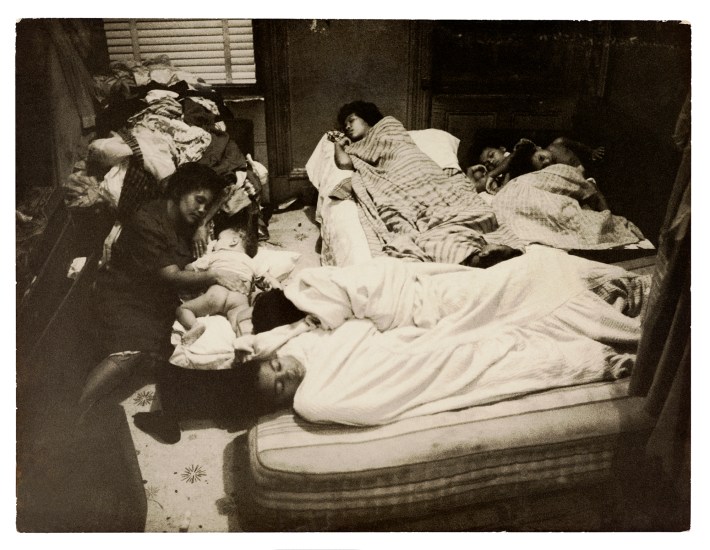The photos tell a common story we’ve come to expect from media representations of abject poverty.
There are the precarious piles of ramshackle dwellings spilling down a steep hillside, where emaciated kids in torn and dirty rags wear pained expressions, mouths agape. Over there, dirty barefoot toddlers run around outside half-naked, no diapers, playing on a cliff of mud and trash outside the front door of the family shack. Inside, too many siblings lay heaped on a too-small bed, the mattress saggy and sodden from all the soiled bodies that sleep there. Gaunt-faced adults look at the camera with sad deep-set eyes, aged beyond their years and tired of life. Next door, the neighbor girl’s lifeless body lies enshrouded, another victim of this impoverished Brazilian favela named Catacumba, or Portuguese for catacomb.

These photographs tell a universal story of survival and perseverance in the face of deadly odds. The images could have been taken at any time in the last hundred years, anywhere in the world where extreme poverty lives next door to grossly exorbitant wealth. But they were taken in 1961 for Life by Gordon Parks, the magazine’s first African American photographer. Parks’ photo essay tells the story of Flávio da Silva, a 12-year-old chronically ill asthmatic living in a Rio de Janeiro favela. Now in his seventies and a decade after the death of the photographer that changed his life, Flávio once again finds himself at the center of media attention. Parks’ compelling photographs of Flávio and his family over the course of three decades are the center of Gordon Parks: The Flávio Story, a timely and stunning new exhibit at the Getty Museum.
An Accidental Subject
Flávio da Silva was not supposed to be the star subject of the documentary photoshoot commissioned by Life magazine.
“Parks regarded poverty as ‘the most savage of all human afflictions."
In January 1961, President John F. Kennedy announced his “Alliance for Progress” (Alianza para el Progreso) initiative to improve diplomatic relations between the U.S. and Latin America. Six months later in June, Life magazine sent Parks, the magazine’s first African American photographer, to “document poverty” in Brazil for a special series on Latin America. Parks’ assignment was to follow the hardworking father and head of the struggling da Silva family living on $25 a month in a Rio favela.

Instead, Parks’ camera-eye was drawn to 12-year-old Flávio, the son and brother who ran the household even though he suffered from a debilitating illness. Parks immediately connected to his inadvertent subject. The photographs show Flávio, “a boy burdened with a family’s cares,” making the bed, feeding his younger siblings, and finally resting alone, his frail body visibly spent.
“Parks regarded poverty as ‘the most savage of all human afflictions,’ in no small part because he was born into destitution,” says Amanda Maddox, co-curator of the exhibition and an associate curator at the Getty Museum.
Before Go Fund Me
Originally published in 1961 under the headline “Freedom’s Fearful Foe: Poverty,” Parks’ raw, intimate portraits of Flávio—sickly but defiant, downtrodden but dignified—sparked sympathy with Life’s readers. Parks’ moving photographs of Flávio and his favela-dwelling family tugged at Americans’ heartstrings, who opened their wallets to tune of $26,000 worth of donations mailed to Life, imploring the magazine to help the da Silvas. That’s $223,000 in 2019, more than any Go Fund Me campaign could have garnered. Even the Children’s Asthma Research Institute and Hospital (CARIH) in Denver, Colorado, offered to treat Flávio as a patient at no cost.

Flávio’s story and Parks’ photographs garnered national and international attention. A month after the initial photo essay was published in Life, the magazine sent Parks back to the Rio favela to photograph Flávio and his family being “rescued” from their slum for a follow-up story. With the readers’ donations, Life purchased a modest home for the da Silva family and photographed the move from their impoverished a shack on the favela hill to a new house in a modest Rio suburb. On the same day, Parks would fly with Flávio back to the US, where the boy would live for two years in Denver while he received medical treatment.
Parks took photographs of the boy living his new—albeit temporary—life in the United States. The ailing Brazilian slum boy, dirty and undernourished just weeks before, now looks happy, healthy, and clean in pictures, thanks to what Life called “the compassion of Americans.” He thrived with his Portuguese-speaking adopted family, who helped the young Brazilian acculturate to an American life filled with pastimes like baseball and Christmas. Photos show Flávio wearing new clothes and playing on playground swings, tossing a ball, and sitting sweetly with a new friend.

“As a photographer [Parks] consciously wielded his camera as a weapon—his chosen term—in an attempt to combat economic and racial inequality,” says Maddox. “Viewed in this context, his documentation of Flávio da Silva—for Life and beyond—reveals the complexity of his empathetic approach and the inherent difficulties of representing someone else’s personal story—a story that resonated with many people over many years—in any form.”
Brazilian Backlash
Despite accolades for Parks, the benevolent “rescue” of the da Silva family, and Flávio’s successful medical treatment, the Brazilian boy’s Life story was no triumph in the eyes of his home country’s press. Journalists at various Brazilian papers and magazines deemed Life’s photos as stereotypical of Latin America, and some charged Parks with staging his photographs and manipulating his subjects.

O Cruzeiro, an illustrated weekly magazine published in Flávio’s hometown of Rio de Janeiro, responded to Life’s coverage of the Catacumba favela by sending their own photographer, Henri Ballot, to capture similar images in the USA.
Ballot went to New York City to document the “American misery” of poverty. His subjects: the Gonzálezes, a family of twelve from Puerto Rico who shared a decaying one-room apartment in Spanish Harlem. His photos bear a striking resemblance to the destitution reflected in Parks’ images of the da Silvas. Through Ballot’s eyes, O Cruzeiro readers saw that poverty’s indignities lived in America, too. Ballot, too, shows us screaming children, barefoot and diaperless toddlers, vermin-infested living quarters, and too many people heaped in one bed. Through Ballot’s eyes, the squalor of Spanish Harlem’s ghetto matched up with everything readers saw in Brazil. Poverty does not just happen in Latin America, the O Cruzeiro story argued.

What poverty looks like
I walked away from the Gordon Parks: The Flávio Story exhibit with the gnawing realization that these images of poverty aren’t really from the past. They’re not just frozen in time, in 1961.
The scenes could have also been plucked from yesterday’s newspaper stories about homeless encampments, refugee camps, and border detention facilities from Hong Kong to southern Europe to the US-Mexico border and downtown Los Angeles. These photos could be from any barrio, ghetto, or “slum” in New York or Rio today.
In Parks’ work, I recognized the almost clichéd themes and representations of abject poverty that evoke everything from Charles Dickens 19th century novels and Frank McCourt’s destitute Depression-era Limerick family of “Angela’s Ashes” fame to Dorothea Lange’s iconic worried mother images of the 1930s Dust Bowl era.

Parks’ Life photos from 1961 look familiar alongside contemporary films like 2002’s City of God or 2008’s Slumdog Millionaires. The scenes could have also been plucked from yesterday’s newspaper stories about homeless encampments, refugee camps, and border detention facilities from Hong Kong to southern Europe to the US-Mexico border and downtown Los Angeles. These photos could be from any barrio, ghetto, or “slum” in New York or Rio today.
Today, Brazil even has its own Trumpian president, the far-right nationalist Jair Bolsonaro. There are still favelas.
Poverty is not ‘over,’ not some enemy to squash in Cold War paranoia, but timeless and pervasive. When rampant capitalism favors the 1% of wealth-hoarding billionaires over the 99-percent of the rest of us, we see extreme poverty all the time as a result. Whether in movies or the media, poverty looks much like it did in 1961. Gordon Parks’ photos from 1961 ask us to confront it today.
The Getty’s collection of over one hundred photos, from Parks’ original Life series to Ballot’s ‘retaliation’ photos for O Cruzeiro, along with handwritten letters, journals, and other ephemera related to Flávio’s incredible story are on view at the Getty Museum through November 10.







